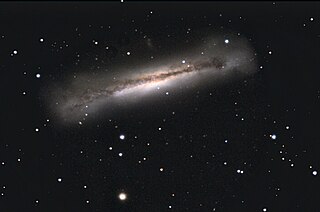
NGC 3628, also known as the Hamburger Galaxy or Sarah's Galaxy, is an unbarred spiral galaxy about 35 million light-years away in the constellation Leo. It was discovered by William Herschel in 1784. It has an approximately 300,000 light-years long tidal tail. Along with M65 and M66, NGC 3628 forms the Leo Triplet, a small group of galaxies. Its most conspicuous feature is the broad and obscuring band of dust located along the outer edge of its spiral arms, effectively transecting the galaxy to the view from Earth.

NGC 659 is an open cluster in the Cassiopeia constellation. It was discovered by Caroline Herschel in 1783.

NGC 2546 is a pair of independent but overlapping open clusters located in the southern constellation of Puppis. This grouping was discovered by French astronomer Abbe Lacaille in 1751-1752 from South Africa. NGC 2546 is just visible to the naked eye as a fuzzy patch; the brightest component has an apparent visual magnitude of 6.44. The brighter members are readily resolved with a pair of 10×50 binoculars.
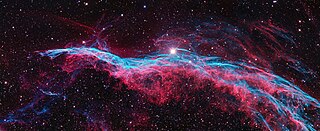
The Veil Nebula is a cloud of heated and ionized gas and dust in the constellation Cygnus.

NGC 1872 is an open cluster within the Large Magellanic Cloud in the constellation Dorado. It was discovered by James Dunlop in 1826.

NGC 5364 is a grand design spiral galaxy located 54.5 million light years away in the constellation Virgo. It is inclined to the line of sight from the Earth at an angle of 47° along a position angle of 25°. It is a member of the NGC 5364 Group of galaxies, itself one of the Virgo III Groups strung out to the east of the Virgo Supercluster of galaxies.

NGC 3242 is a planetary nebula located in the constellation Hydra.

NGC 559 is an open cluster and Caldwell object in the constellation Cassiopeia. It shines at magnitude +9.5. Its celestial coordinates are RA 01h 29.5m, dec +63° 18′. It is located near the open cluster NGC 637, and the bright magnitude +2.2 irregular variable star Gamma Cassiopeiae. The cluster is 7 arcmins across.
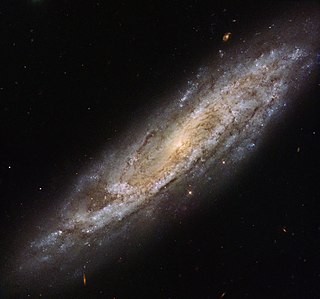
NGC 2770 is a spiral galaxy in the northern constellation of Lynx, near the northern constellation border with Cancer. It was discovered by German-born astronomer William Herschel on December 7, 1785. J. L. E. Dreyer described it as, "faint, large, much extended 150°, mottled but not resolved, 2 stars to north". NGC 2770 was the target for the first binocular image produced by the Large Binocular Telescope.
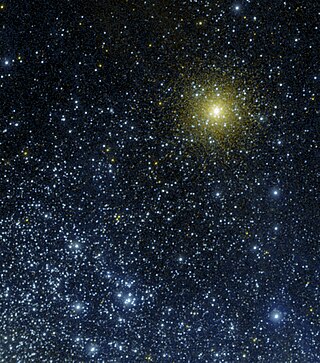
NGC 362 is a globular cluster located in the constellation Tucana in the Southern Hemisphere, slightly north of the Small Magellanic Cloud, to which it is completely unrelated. It was discovered on August 1, 1826, by James Dunlop. It is visible to the naked eye in dark skies, and is an impressive sight in a telescope, although it is somewhat overshadowed by its larger and brighter neighbour 47 Tucanae.

NGC 7008, also known as the Fetus Nebula is a planetary nebula with a diameter of approximately 1 light-year located at a distance of 2800 light years in northern Cygnus. It was discovered by William Herschel in 1787, in Slough, England. NGC 7008 is included in the Astronomical League's Herschel 400 observing program.NGC 7008 is that its intricate and delicate structures make it a fascinating target for both amateur and professional astronomers studying the late stages of stellar evolution and the formation of planetary nebulae.

NGC 1535 is a planetary nebula in the constellation of Eridanus, discovered by William Herschel on February 1, 1785. It is very similar to the Eskimo Nebula in both color and structure but the central star can be quite difficult to observe visually. The object is included in the Astronomical League's Herschel 400 Observing Program.

NGC 1579 is a diffuse nebula located in the constellation of Perseus. It is referred to as the Northern Trifid because of its similar appearance to the Trifid Nebula, which is located in the southern celestial hemisphere of the sky. It is a H II region, a region of star formation.

NGC 3377 is an elliptical galaxy in the constellation Leo. It is a member of the M96 Group and is about 26 Mly away, with a diameter of approximately 40 000 ly. The supermassive black hole at the core of NGC 3377 has a mass of 8.0+0.5
−0.6×107 M☉. A very faint companion galaxy, NGC 3377A is 7.1' NW.

NGC 51 is a lenticular galaxy in the constellation Andromeda. It has a diameter of 90,000 light-years. The galaxy was discovered on September 7, 1885, by Lewis Swift, who described it as "Pretty faint, pretty small, round, brighter middle."

NGC 70 is a spiral galaxy located in the constellation Andromeda. It was discovered on October 7, 1855, by R. J. Mitchell and was also observed on December 19, 1897 by Guillaume Bigourdan from France who described it as "extremely faint, very small, round, between 2 faint stars".

NGC 72 is a barred spiral galaxy estimated to be about 320 million light-years away in the constellation of Andromeda. It was discovered by R. J. Mitchell in 1855 and its magnitude is 13.5.
NGC 6925 is an unbarred spiral galaxy in the constellation Microscopium of apparent magnitude 11.3. It is lens-shaped, as it lies almost edge on to observers on Earth. It lies 3.7 degrees west-northwest of Alpha Microscopii.
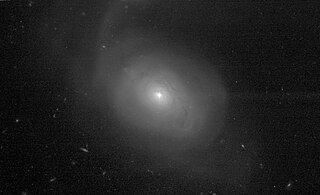
NGC 7603 is a spiral Seyfert galaxy in the constellation Pisces. It is listed in the Atlas of Peculiar Galaxies. It is interacting with the smaller elliptical galaxy PGC 71041 nearby.
NGC 5662 is an open cluster in the constellation Centaurus. It was discovered by Nicolas Louis de Lacaille on May 17, 1752 from South Africa. James Dunlop observed it on July 10, 1826 from Parramatta, Australia and added it to his catalog as No. 342.

















